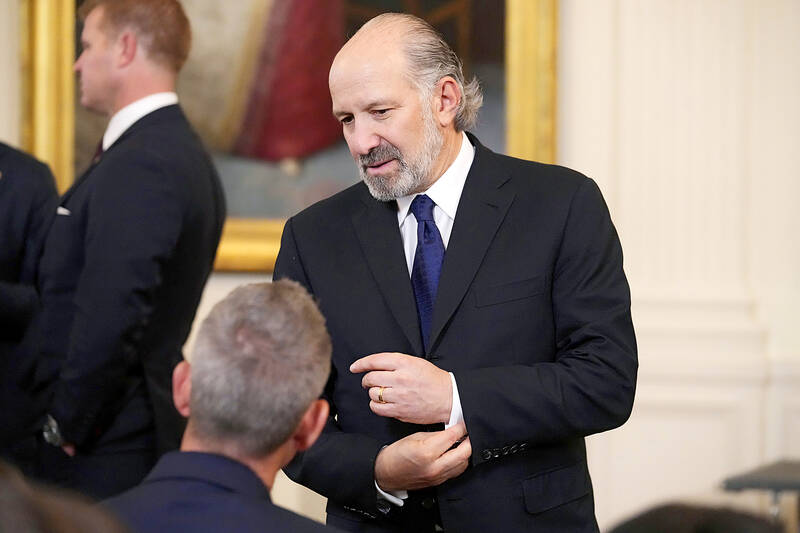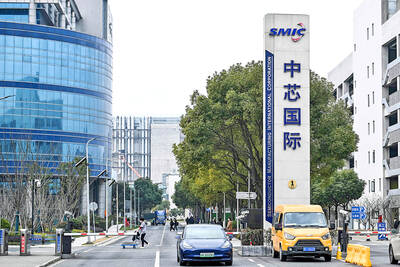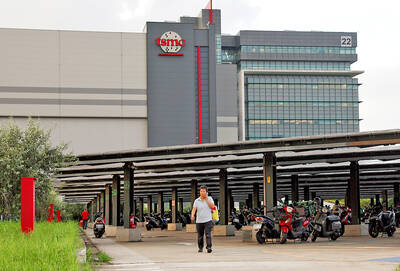The US and China have finalized a trade understanding reached last month in Geneva, Switzerland, US Secretary of Commerce Howard Lutnick said on Thursday, adding that the White House has imminent plans to reach agreements with a set of 10 major trading partners.
The China deal, which Lutnick said had been signed this week, codifies the terms laid out in trade talks between Beijing and Washington, including a commitment from China to deliver rare earths used in everything from wind turbines to jet planes.
“They’re going to deliver rare earths to us” and once they do that, “we’ll take down our countermeasures,” Lutnick told Bloomberg News in an interview.

Photo: AP
China said it has further confirmed details of a trade framework with the US, echoing Lutnick’s earlier comments about a US-China agreement.
A spokesperson for the Chinese Ministry of Commerce made the announcement in a statement yesterday, while reiterating that it would continue to approve export permits of controlled items.
A White House official said that the US and China agreed to the terms to implement the Geneva accord.
The China agreement sets out the terms laid out in trade talks between Beijing and Washington this year — a milestone after both sides have accused each other of contravening the terms of previous handshake accords. Yet it still hinges on future actions by both nations, including China’s export of rare earths.
Lutnick told Bloomberg Television that US President Donald Trump was also prepared to finalize a slate of trade deals in the coming two weeks in connection with the president’s July 9 deadline to reinstate higher tariffs he paused in April.
“We’re going to do top 10 deals, put them in the right category, and then these other countries will fit behind,” he said.
Lutnick did not specify which nations would be part of that first wave of trade pacts, although earlier on Thursday Trump suggested the US was nearing an agreement with India.
The president has also said that he would ultimately send “letters” to nations dictating trade terms if agreements are not reached in time.
Nations would be sorted into “proper buckets” on July 9, Lutnick said.
Trump could also extend deadlines to allow for more talks.
“Those who have deals will have deals, and everybody else that is negotiating with us, they’ll get a response from us and then they’ll go into that package,” Lutnick said. “If people want to come back and negotiate further, they’re entitled to, but that tariff rate will be set and off we’ll go.”
Trump announced so-called “reciprocal” rates — reaching as high as 50 percent — on April 2, but later paused the bulk of them for 90 days to allow for negotiations.
It is not yet clear how comprehensive the trade deals would be. Trade agreements typically take years — not mere months — to negotiate. An earlier pact with the UK still leaves major questions undecided, including a discount for some imported metals.
The agreement comes as the US moves to ease restrictions on exports of ethane, with the US Department of Commerce earlier this week telling energy companies they could load that petroleum gas on to tankers and ship it to China, but not unload it there without authorization.

NO BREAKTHROUGH? More substantial ‘deliverables,’ such as tariff reductions, would likely be saved for a meeting between Trump and Xi later this year, a trade expert said China launched two probes targeting the US semiconductor sector on Saturday ahead of talks between the two nations in Spain this week on trade, national security and the ownership of social media platform TikTok. China’s Ministry of Commerce announced an anti-dumping investigation into certain analog integrated circuits (ICs) imported from the US. The investigation is to target some commodity interface ICs and gate driver ICs, which are commonly made by US companies such as Texas Instruments Inc and ON Semiconductor Corp. The ministry also announced an anti-discrimination probe into US measures against China’s chip sector. US measures such as export curbs and tariffs

The US on Friday penalized two Chinese firms that acquired US chipmaking equipment for China’s top chipmaker, Semiconductor Manufacturing International Corp (SMIC, 中芯國際), including them among 32 entities that were added to the US Department of Commerce’s restricted trade list, a US government posting showed. Twenty-three of the 32 are in China. GMC Semiconductor Technology (Wuxi) Co (吉姆西半導體科技) and Jicun Semiconductor Technology (Shanghai) Co (吉存半導體科技) were placed on the list, formally known as the Entity List, for acquiring equipment for SMIC Northern Integrated Circuit Manufacturing (Beijing) Corp (中芯北方積體電路) and Semiconductor Manufacturing International (Beijing) Corp (中芯北京), the US Federal Register posting said. The

READY TO HELP: Should TSMC require assistance, the government would fully cooperate in helping to speed up the establishment of the Chiayi plant, an official said Taiwan Semiconductor Manufacturing Co (TSMC, 台積電) yesterday said its investment plans in Taiwan are “unchanged” amid speculation that the chipmaker might have suspended construction work on its second chip packaging plant in Chiayi County and plans to move equipment arranged for the plant to the US. The Chinese-language Economic Daily News reported earlier yesterday that TSMC had halted the construction of the chip packaging plant, which was scheduled to be completed next year and begin mass production in 2028. TSMC did not directly address whether construction of the plant had halted, but said its investment plans in Taiwan remain “unchanged.” The chipmaker started

MORTGAGE WORRIES: About 34% of respondents to a survey said they would approach multiple lenders to pay for a home, while 29.2% said they would ask family for help New housing projects in Taiwan’s six special municipalities, as well as Hsinchu city and county, are projected to total NT$710.65 billion (US$23.61 billion) in the upcoming fall sales season, a record 30 percent decrease from a year earlier, as tighter mortgage rules prompt developers to pull back, property listing platform 591.com (591新建案) said yesterday. The number of projects has also fallen to 312, a more than 20 percent decrease year-on-year, underscoring weakening sentiment and momentum amid lingering policy and financing headwinds. New Taipei City and Taoyuan bucked the downturn in project value, while Taipei, Hsinchu city and county, Taichung, Tainan and Kaohsiung